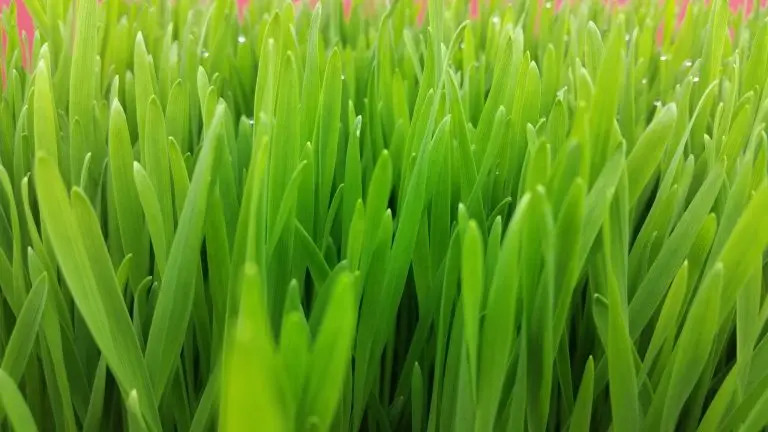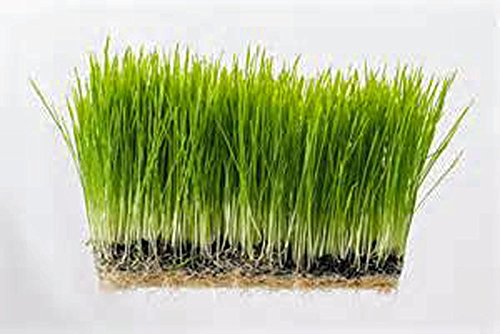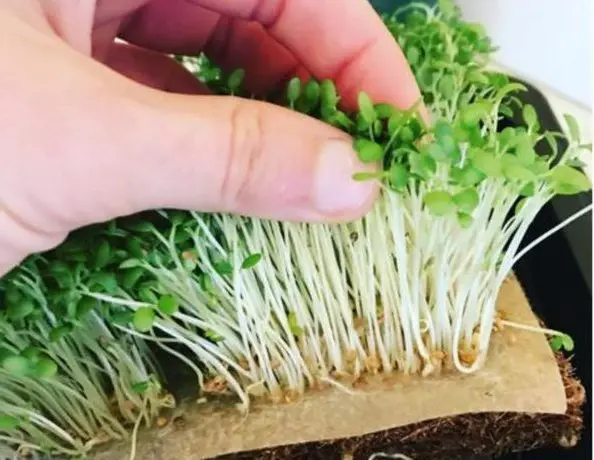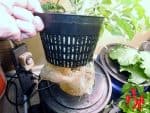This post contains affiliate links. If you buy something from one of our links we may earn a commission. Thanks

Do you want to learn how to grow wheatgrass microgreens? They are easy to grow, even for beginners, and require minimal space and materials.
Growing Wheatgrass Microgreens is straightforward and quick. Use a shallow tray filled with organic soil and scatter wheatgrass seeds on top. Lightly cover with soil and water. Place the tray in a location with indirect sunlight and keep the soil moist. Harvest when the grass is about 6-7 inches tall.
Wheatgrass microgreens are a tasty and nutritious addition to any diet and we’ll walk you through the steps for growing your own wheatgrass microgreens at home in just a few easy steps.
What Are Wheatgrass Microgreens?
Wheatgrass microgreens are a type of edible plant that is grown from the young shoots of the wheat plant (Triticum aestivum).
They are typically grown in soil or can be grown hydroponically and are harvested when they are just a few inches tall, at the cotyledon or first true leaf stage.
Wheatgrass microgreens have a grassy, slightly sweet flavor and are often used in smoothies, salads, and fresh wheatgrass juice. They are also sometimes consumed as a shot or in supplements.
Wheatgrass microgreens are a good source of vitamins and minerals, including vitamins A, C, and E, and have been claimed to have a number of health benefits like providing an immune system boost, although the scientific evidence supporting these claims is limited.
Cat Grass For Pets
Wheatgrass is also a cat grass. It is often used as a type of grass for cats to eat. Cats are known to nibble on grass or other plants for various reasons, including to aid in digestion or as a natural way to consume necessary fiber.
The most common benefit of cat grass is helping the passing of hairballs. Wheatgrass is a type of cat grass that is relatively easy to grow and can be a healthy, safe option for cats to eat.
Benefits of Growing Your Own Wheatgrass Microgreens
Growing your own wheatgrass microgreens has a number of benefits:
• It allows you to have a constant supply of fresh microgreens on hand.
• It allows you to control the growing conditions, ensuring that your microgreens are grown in a healthy and sustainable manner.
• It can save you money in the long run, as buying microgreens from the grocery store can be expensive.

Suitable for Beginners – It’s Easy To Grow Wheatgrass!
One of the great things about growing wheatgrass microgreens is that it is suitable for beginners.
Microgreens are easy to grow and wheatgrass microgreens are one of the easiest microgreen varieties to grow.
Unlike many other types of gardening, microgreens require minimal space and equipment, and they grow quickly, making it easy to get started.
With just a few basic materials and a bit of care, you can have a crop of fresh microgreens in just a few days.
How To Grow Wheatgrass Microgreens In 7 Easy Steps
Materials Needed
To get started growing your own wheatgrass microgreens, you’ll need a few basic materials. Here’s what you’ll need:
Wheatgrass seeds: Wh eatgrass microgreens are grown from wheat seeds.
eatgrass microgreens are grown from wheat seeds.
You can purchase wheat seeds from a gardening store or online.
Make sure you buy organic seeds that are non-GMO. Some seeds sold for farm use are treated with chemicals so you don’t want to use them.
You will need about 3 ounces of seed to plant a 1020 tray.
Trays or pots:
 You’ll need a tray or pot to grow your microgreens in.
You’ll need a tray or pot to grow your microgreens in.
Trays are typically easier to use, as they have drainage holes and are easier to water.
However, pots will also work if you don’t have a tray.
Bootstrap Farmer makes really strong trays that will last for many years.
For best results get a tray with drainage holes to hold your grow medium. Then get a tray without holes to set it in.
The lower tray can be used to bottom water your seeds. This is the best way to water young seedlings because they won’t be uncovered or moved around as they can be with top watering.
Soil or hydroponic system: You’ll need soil like a potting mix or a hydroponic system to grow your microgreens in.
How To Grow Wheatgrass In Soil
If you’re using soil, make sure to use high-quality, well-draining soil. Coco coir is the ideal growing medium for growing wheatgrass.
It has good water-holding capacity yet it drains well. It is lighter than soil and excellent for germinating seeds and will give you the best germination rates.
How To Grow Wheatgrass Without Soil
If you’re thinking about using a hydroponic system, you’ll need a growing medium, such as coconut coir or Rockwool, and a container to hold the medium.
 I recommend coco grow mats as the easiest way to grow wheatgrass without soil. Some people even grow wheatgrass on paper towels.
I recommend coco grow mats as the easiest way to grow wheatgrass without soil. Some people even grow wheatgrass on paper towels.
Water: You’ll need water to keep your microgreens hydrated. Make sure to use clean, fresh water, as chlorine and other chemicals can be harmful to plants.
Optional: grow lights: If you don’t have access to natural sunlight, you may want  to consider using grow lights to provide enough light for your microgreens.
to consider using grow lights to provide enough light for your microgreens.
Wheatgrass microgreens need plenty of light to grow, so make sure to provide enough light for your plants.
Step 1: Soak the Seeds
The first step in growing wheatgrass microgreens is to soak the seeds. To do this, simply place the seeds in a bowl or jar and cover them with water. Let the seeds soak for 8-12 hours
Step 2: Prepare the Trays or Pots
Once the seeds have finished soaking, it’s time to prepare your trays or pots.
If you’re using soil, fill the tray or pot with high-quality, well-draining soil. Make sure the soil is moist, but not saturated with too much water.
If you’re using a hydroponic system, fill the container with your chosen growing medium and make sure it is moist, but not saturated.
Step 3: Plant the Seeds
Next, it’s time to plant the seeds. Sprinkle the soaked seeds evenly over the surface of the soil or growing medium, making sure to space them out evenly.
Gently press the seeds into the soil or medium to ensure good contact. Seeds germinate fast usually in 2-3 days.
In hydroponics, if you’d like, you can add a thin layer of vermiculite or perlite on top of the growing medium to help retain moisture.
If you are growing in soil you can cover the seeds with a thin layer of soil.
Step 4: Water and Cover
After planting the seeds, it’s important to water them gently, making sure not to wash them away.
Use a spray bottle to mist them. Make sure to drain off any excess water.
Once the seeds are watered, cover the tray or pot with a clear plastic dome or cover to create a humid environment.
This will help to keep the seeds moist and encourage germination. Keep your tray at room temperature.
I use an empty seed flat to cover the seeds but I remove it as soon as they sprout.
Step 5: Place in a Sunny Spot or Under Grow Lights
Wheatgrass microgreens only need indirect sunlight to grow, but you will get better results and the leaves will be much greener if they get bright light.
So make sure to place your tray or pot in a sunny window or under grow lights.
If you don’t have access to natural sunlight, use grow lights to provide enough light for your microgreens.
Step 6: Water and Mist Regularly
In order for your wheatgrass microgreens to grow properly, it’s important to keep the soil or growing medium moist, but not saturated.
Water the microgreens as needed, being careful not to overwater them. You can also mist the microgreens with water to provide additional humidity.
Step 7: Harvest Time!
After just 7-10 days your wheatgrass microgreens will be ready to harvest.
Wheatgrass microgreens are ready to harvest when they are about 2-3 inches tall and have their first true leaves.
To harvest the microgreens, simply cut them just above the soil line using scissors. Rinse and dry the microgreens, then use them in salads, smoothies, or as garnish.
Disclaimer: I am not a physician and don’t play one on TV either. The material on this site is not a substitute for professional medical advice, diagnosis, or treatment. Always seek a physician’s advice before using any information you find on this website to treat or prevent any condition.
Wheatgrass Microgreens Benefits
Wheatgrass has become very popular for its health benefits and is very popular in health food stores and juice bars. It is considered a superfood, with a high nutritional value.
Wheatgrass is an excellent source of many different vitamins and minerals. It is especially high in vitamins A, C and E, as well as iron, magnesium, calcium and amino acids.
Of its 17 amino acids, eight are considered essential, meaning your body cannot produce them and you must obtain them from food sources. https://www.healthline.com/nutrition/wheatgrass-benefits
Wheatgrass Microgreens Nutrition
According to WebMD
Health food enthusiasts have talked about the health benefits of wheatgrass for years. While more research is needed to prove the claims, studies are finding that the young wheat may potentially provide several important benefits.
Wheatgrass is low in calories but high in nutrients, including antioxidants such as glutathione, vitamin C, and vitamin E. Antioxidants fight free radicals in the body, reducing oxidative stress and protecting against health conditions like arthritis, cancer, and neurodegenerative diseases.
Nutritional Info
from the WebMD Ingredients Guide
Serving Size 1 Serving
Calories10
% Daily Value*
Total Fat 0 g 0%
Saturated Fat 0 g 0%
Trans Fat 0 g
Cholesterol 0 mg 0%
Sodium 5 mg 0%
Potassium 0 mg 0%
Total Carbohydrate 2 g 1%
Dietary Fiber 0 g 0%
Sugar 1 g
Protein 1 g 2%
*Percent Daily Values are based on a 2,000 calorie diet. Your daily values may be higher or lower depending on your calorie needs.Vitamin C 15%
Iron 22%
Vitamin B6 0%
Magnesium 0%
Calcium 0%
Vitamin D 0%
Cobalamin 0%
Vitamin A 0%
FAQs
How Do You Use Wheatgrass Microgreens?
There are many ways to use wheatgrass microgreens in your cooking and daily routine. Here are a few ideas:
• Juice: Wheatgrass microgreens can be juiced and consumed as a shot or mixed with other juices for a nutrient boost.
• Smoothies: Add a handful of wheatgrass microgreens to your smoothie for a burst of flavor and nutrition.
• Salads: Use wheatgrass microgreens as a garnish or mix them in with your salad greens for a unique flavor and added nutritional value.
• Sandwiches and wraps: Top your sandwiches or wraps with a sprinkle of wheatgrass microgreens for a crunchy, grassy flavor.
• Supplements: Wheatgrass microgreens can be consumed in supplement form, either as capsules or in powdered form that can be added to water or other beverages.
• Garnish: Use wheatgrass microgreens as a garnish on top of soups, stews, and other dishes for a pop of color and flavor.
It’s important to note that while wheatgrass microgreens are a good source of vitamins and minerals, they should not be relied upon as a sole source of nutrition.
As with any food, it’s important to consume a varied and balanced diet to ensure that you are getting all the nutrients your body needs.
Can You Grow Wheatgrass Sprouts In A Mason Jar?
Yes, it is possible to grow wheatgrass sprouts in a mason jar. Wheatgrass is a type of grass that is grown from wheat seeds and is high in nutrients. It is often used as a dietary supplement in juice or smoothie form.
To grow wheatgrass sprouts in a mason jar, you will need:
If you’d like, you can add a thin layer of vermiculite or perlite on top of the growing medium to help retain moisture.
If you’d like, you can add a thin layer of vermiculite or perlite on top of the growing medium to help retain moisture.
If you’d like, you can add a thin layer of vermiculite or perlite on top of the growing medium to help retain moisture.
• Wheat seeds
• A mason jar with a lid
• Water
To start, fill the mason jar with water and soak the wheat seeds for about 8 hours. Drain the water and rinse the seeds, then place them back in the jar.
Cover the top of the jar with the lid, and place it in a warm, well-lit location. Rinse and drain the seeds twice a day to keep them moist. The seeds should sprout in a few days.
Wheatgrass Microgreens FAQs
Wheatgrass microgreens are a popular addition to smoothies, juices, and even some recipes, but growing them at home can bring up some questions.
To make your wheatgrass-growing experience as smooth as possible, we’ve compiled a list of frequently asked questions and their answers.
Q: When is the best time to harvest wheatgrass microgreens?
A: Harvest when the grass reaches a height of about 6-7 inches, usually 7-10 days after planting.
Q: Do I need to use organic soil?
A: While not mandatory, organic soil is recommended to ensure the highest nutrient content in your wheatgrass.
Q: Can I grow wheatgrass without soil?
A: Yes, wheatgrass can also be grown hydroponically with coco mats, although soil-grown is often used.
Q: Is wheatgrass safe for pets?
A: Wheatgrass is generally safe for pets like cats and dogs to consume in small amounts, but always consult with a veterinarian first.
Final Thoughts
Growing wheatgrass microgreens is a fun and easy way to add a burst of nutrition and flavor to your meals.
With just a few materials and a bit of care, you can have a crop of fresh microgreens in just a few days.
Whether you’re a seasoned gardener or a beginner, growing wheatgrass microgreens is a rewarding and enjoyable experience.









